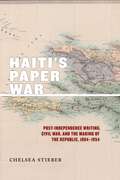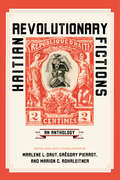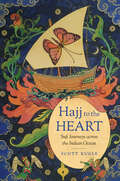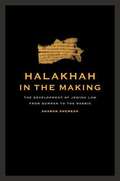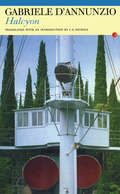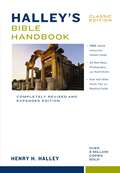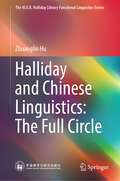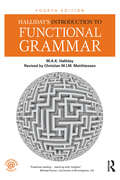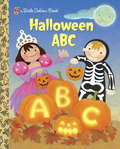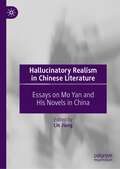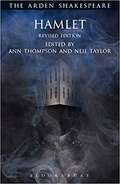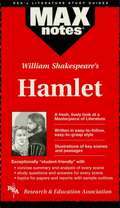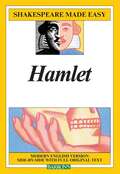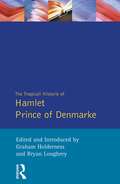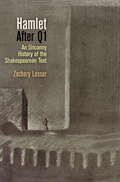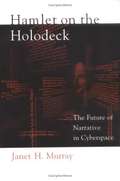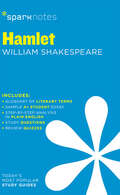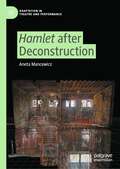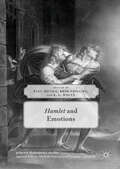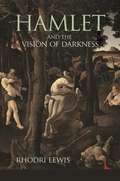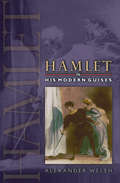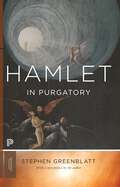- Table View
- List View
Haiti's Paper War: Post-Independence Writing, Civil War, and the Making of the Republic, 1804–1954 (America and the Long 19th Century #25)
by Chelsea Stieber2021 Outstanding Academic Title, Choice MagazineTurns to the written record to re-examine the building blocks of a nationPicking up where most historians conclude, Chelsea Stieber explores the critical internal challenge to Haiti’s post-independence sovereignty: a civil war between monarchy and republic. What transpired was a war of swords and of pens, waged in newspapers and periodicals, in literature, broadsheets, and fliers. In her analysis of Haitian writing that followed independence, Stieber composes a new literary history of Haiti, that challenges our interpretations of both freedom struggles and the postcolonial. By examining internal dissent during the revolution, Stieber reveals that the very concept of freedom was itself hotly contested in the public sphere, and it was this inherent tension that became the central battleground for the guerre de plume—the paper war—that vied to shape public sentiment and the very idea of Haiti.Stieber’s reading of post-independence Haitian writing reveals key insights into the nature of literature, its relation to freedom and politics, and how fraught and politically loaded the concepts of “literature” and “civilization” really are. The competing ideas of liberté, writing, and civilization at work within postcolonial Haiti have consequences for the way we think about Haiti’s role—as an idea and a discursive interlocutor—in the elaboration of black radicalism and black Atlantic, anticolonial, and decolonial thought. In so doing, Stieber reorders our previously homogeneous view of Haiti, teasing out warring conceptions of the new nation that continued to play out deep into the twentieth century.
Haitian Revolutionary Fictions: An Anthology (New World Studies)
by Marlene L. Daut, Grégory Pierrot, and Marion C. RohrleitnerThe Haitian Revolution (1791–1804) was the first antislavery and anticolonial uprising led by New World Africans to result in the creation of an independent and slavery-free nation state. The momentousness of this thirteen-year-long war generated thousands of pages of writing. This anthology brings together for the first time a transnational and multilingual selection of literature about the revolution, from the beginnings of the conflicts that resulted in it to the end of the nineteenth century.With over two hundred excerpts from novels, poetry, and plays published between 1787 and 1900, and depicting a wide array of characters including, Anacaona, Makandal, Boukman, Toussaint Louverture, Jean-Jacques Dessalines, and Henry Christophe, this anthology provides the perfect classroom text for exploring this fascinating revolution, its principal actors, and the literature it inspired, while also providing a vital resource for specialists in the field. This landmark volume includes many celebrated authors—such as Alexandre Dumas, Victor Hugo, Heinrich von Kleist, Alphonse de Lamartine, William Wordsworth, Harriet Martineau, and William Edgar Easton—but the editors also present here for the first time many less-well-known fictions by writers from across western Europe and both North and South America, as well as by nineteenth-century Haitian authors, refuting a widely accepted perception that Haitian representations of their revolution primarily emerged in the twentieth century. Each excerpt is introduced by contextualizing commentary designed to spark discussion about the ongoing legacy of slavery and colonialism in the Americas. Ultimately, the publication of this capacious body of literature that spans three continents offers students, scholars, and the curious reader alike a unique glimpse into the tremendous global impact the Haitian Revolution had on the print culture of the Atlantic world.New World Studies
Hajabala class 6 - West Bengal Board: হ য ব র ল ষষ্ঠ শ্রেণির
by West Bengal Board of Secondary Educationহ য ব র ল, সুকুমার রায়ের কালজয়ী রচনা, বাংলা সাহিত্যের এক অনন্য নিদর্শন যা এর হেঁয়ালিপূর্ণ মজা ও খেয়ালি গল্পের জন্য পাঠকদের হৃদয় জয় করেছে। পশ্চিমবঙ্গ মধ্যশিক্ষা পর্ষদ কর্তৃক ষষ্ঠ শ্রেণির দ্রুতপাঠনের পাঠ্যপুস্তক হিসেবে গৃহীত এই গ্রন্থটি পাঠকদের এক চমকপ্রদ কল্পনার জগতে নিয়ে যায়। এখানে প্রাণীদের কথা বলা, গেছো দাদার মতো অদ্ভুত চরিত্র এবং হাস্যকর ঘটনা পাঠকদের মুগ্ধ করে। এর অদ্ভুত সংলাপ ও পরিহাসমূলক বুদ্ধিমত্তা শুধু আনন্দই দেয় না, বরং সৃজনশীলতা ও সমালোচনামূলক চিন্তার বিকাশেও সহায়তা করে। ২০১৩ সালে প্রথম প্রকাশিত এবং ২০১৪ সালে সংশোধিত এই বইটি শিক্ষার্থীদের ভাষা ও সাহিত্য চর্চায় আগ্রহ বাড়ানোর পাশাপাশি তাদের পঠন দক্ষতাও উন্নত করতে সাহায্য করে।
Hajj to the Heart: Sufi Journeys across the Indian Ocean (Islamic Civilization and Muslim Networks)
by Scott KugleAgainst the sweeping backdrop of South Asian history, this is a story of journeys taken by sixteenth-century reformist Muslim scholars and Sufi mystics from India to Arabia. At the center is the influential Sufi scholar Shaykh Ali Muttaqi and his little-known network of disciples. Scott Kugle relates how Ali Muttaqi, an expert in Arabic, scriptural hermeneutics, and hadith, left his native South Asia and traversed treacherous seas to make the Hajj to Mecca. Settling in Mecca, he continued to influence his homeland from overseas. Kugle draws on his original translations of Arabic and Persian manuscripts, never before available in English, to trace Ali Muttaqi's devotional writings, revealing how the Hajj transformed his spiritual life and political loyalties. The story expands across three generations of peripatetic Sufi masters in the Mutaqqi lineage as they travel for purposes of pilgrimage, scholarship, and sometimes simply for survival along Indian Ocean maritime routes linking global Muslim communities. Exploring the political intrigue, scholarly debates, and diverse social milieus that shaped the colorful personalities of his Sufi subjects, Kugle argues for the importance of Indian Sufi thought in the study of hadith and of ethics in Islam. We are proud to announce that this book is freely available in an open-access enhanced edition thanks to TOME (Toward an Open Monograph Ecosystem)—a collaboration of the Association of American Universities, the Association of University Presses, and the Association of Research Libraries—and the generous support of Emory University and the Andrew W. Mellon Foundation. Learn more at the TOME website: openmonographs.org. The open-access enhanced edition of Hajj to the Heart can be found here: https://manifold.ecds.emory.edu/projects/hajj-to-the-heart
Hal and Nip
by Barbara W. MakarA systematic, phonics-based early reading program that includes: the most practice for every skill, decodable readers for every skill, and reinforcement materials--help struggling students succeed in the regular classroom
Halakhah in the Making: The Development of Jewish Law from Qumran to the Rabbis
by Aharon ShemeshHalakhah in the Making offers the first comprehensive study of the legal material found in the Dead Sea Scrolls and its significance in the greater history of Jewish religious law. Aharon pioneering study revives an issue long dormant in religious scholarship: namely, the relationship between rabbinic laws.
Halcyon: Gabriel d'Annunzio
by J. G. NicholsFirst published in 2003. GABRIELE D'ANNUNZIO was born in 1863 in Pescara, on the Adriatic coast of Italy, the son of a wealthy landowner. His first volume of poetry was published in 1879, when he was sixteen. After graduating from the University of Rome, d'Annunzio married and began to write short stories to support his wife and family. In 1919 d'Annunzio led a small force to seize the town of Fiume, ruling it as a dictator until 1921. D'Annunzio spent the later part of his life at his home on Lake Garda. In 1937 he was made President of the Italian Royal Academy. He died in 1938 and was given a state funeral by Mussolini. When Halcyon was first published, at the end of 1903, its author was already forty and famous: J/ placere, which ranks with A rebours and The Picture of Dorian Gray as a novel of the Decadence, had appeared in 1889, and d'Annunzio had published other novels, short stories, plays, and many volumes of poetry since his first great success at the age of sixteen.
Halley's Bible Handbook, Classic Edition
by Henry H. HalleyThe bestselling Bible handbook of all time with millions of copies sold, the Halley's Bible Handbook makes the Bible's wisdom and message accessible to everyone. The beloved and classic Bible companion has been thoroughly updated, while retaining its time-honored features and Dr. Halley's highly personal style, to offer even greater clarity, insight, and usefulness.Whether you've read the Bible many times or never before, you will find insights that provide a firmer grasp of God's Word and an appreciation for the cultural, religious, and geographic settings in which the story of the Bible unfolds. Written for both mind and heart, this completely revised, updated, and expanded edition features:All-new maps, photographs, and illustrationsContemporary designPractical Bible reading programsHelpful tips for Bible studyFascinating archaeological informationEasy-to-understand sections on how we got the Bible and on church historyImproved indexes
Halliday and Chinese Linguistics: The Full Circle (The M.A.K. Halliday Library Functional Linguistics Series)
by Zhuanglin HuThis book is a progressive exposition on Halliday's academic thought and its origins by the renowned linguist Hu Zhuanglin, based on 30 years of research. The first part, "Chinese Origin," introduces readers to the author's gradual understanding that Halliday's academic thought mainly came from Chinese scholars such as Wang Li, Luo Changpei, and Gao Mingkai. In 1980s, Halliday and his students introduced the theory of Systemic Functional Linguistics into the foreign language and linguistics circles in China; thus, Halliday's academic thought returned to where it originated. The second part, "A Discussion of Theories," mainly addresses the author's experience and further discussions after learning Halliday's theory. The theme of the third part is "Discourse Analysis" and focuses on the greatest difference between Systemic Functional Linguistics and traditional grammar—sentence grammar. Halliday emphasizes the study of "discourse," and sentences are only the embodiment of discourse atthe next level. The fourth part, "The Study of Chinese," applies Halliday's linguistic theory to the evolution of the research of the Chinese language in China, which can better explain the theme of "return" and is of great significance for Chinese scholars' understanding and application of Halliday's academic thought.
Halliday's Introduction to Functional Grammar
by Christian M.I.M. Matthiessen M.A.K. HallidayFully updated and revised, this fourth edition of Halliday's Introduction to Functional Grammar explains the principles of systemic functional grammar, enabling the reader to understand and apply them in any context. Halliday's innovative approach of engaging with grammar through discourse has become a worldwide phenomenon in linguistics. Updates to the new edition include: Recent uses of systemic functional linguistics to provide further guidance for students, scholars and researchers More on the ecology of grammar, illustrating how each major system serves to realise a semantic system A systematic indexing and classification of examples More from corpora, thus allowing for easy access to data Halliday's Introduction to Functional Grammar, Fourth Edition, is the standard reference text for systemic functional linguistics and an ideal introduction for students and scholars interested in the relation between grammar, meaning and discourse.
Halloween ABC (Little Golden Book)
by Sarah Albee Julia WoolfABC fun, dressed up as a Halloween book!Little ones will enjoy this colorful book about a bunch of trick-ortreaters from A to Z (an angel, a ballerina, a cowboy, and so on) and their fun, "spooky" adventures around the neighborhood!
Hallucinatory Realism in Chinese Literature: Essays on Mo Yan and His Novels in China
by Lin JiangThis edited collection of 14 essays presents the most enlightening research findings on Mo Yan and his novels. The authors of the contributions are renowned Chinese scholars and critics from Mainland China, Chinese Hong Kong, and Taiwan like Li Jingze, vice president of Chinese Writers Association, Guo Jie, doctoral supervisor and vice president of South China Normal University, Cheng Guangwei, professor and doctoral supervisor of Renmin University of China, etc. In the book, a large range of topics have been discussed and explored, such as Mo Yan and the Chinese spirit, the revelation of Mo Yan, hallucination and localization, and folkness in The Transparent Carrot, Life and Death Are Wearing Me Out, Red Sorghum Clan, Big Breasts and Wide Hips, The Republic of Wine, Sandalwood Death, and Frog. This collection provides English readers and researchers the opportunity to learn what Chinese scholars and critics have argued about Mo Yan's styles and themes, as well as his relationship to the long canon of Chinese literature. Such a collection with fluid and yet accurate translations, the first of its kind in English, brings to the Western world the Chinese sensibility and critical analysis of this living Chinese Nobel laureate and his novels.
Hamlet (Arden Shakespeare)
by William Shakespeare Ann Thompson Neil TaylorThis Arden edition of Hamlet, arguably Shakespeare's greatest tragedy, presents an authoritative, modernized text based on the Second Quarto text with a new introductory essay covering key productions and criticism in the decade since its first publication. <p><p> A timely up-date in the 400th anniversary year of Shakespeare's death which will ensure the Arden edition continues to offer students a comprehensive and current critical account of the play, alongside the most reliable and fully-annotated text available.
Hamlet (MAXNotes Literature Guides)
by Joanne MillerREA's MAXnotes for William Shakespeare's Hamlet The MAXnotes offers a comprehensive summary and analysis of Hamlet and a biography of William Shakespeare. Places the events of the play in historical context and discusses each act in detail. Includes study questions and answers along with topics for papers and sample outlines.
Hamlet (Shakespeare Made Easy)
by William ShakespeareHere are the books that help teach Shakespeare plays without the teacher constantly needing to explain and define Elizabethan terms, slang, and other ways of expression that are different from our own. Each play is presented with Shakespeare's original lines on each left-hand page, and a modern, easy-to-understand "translation" on the facing right-hand page. All dramas are complete, with every original Shakespearian line, and a full-length modern rendition of the text. These invaluable teaching-study guides also include: Helpful background information that puts each play in its historical perspective. Discussion questions that teachers can use to spark student class participation, and which students can use as springboards for their own themes and term papers. Fact quizzes, sample examinations, and other features that improve student comprehension of what each play is about.
Hamlet (The New Cambridge Shakespeare)
by William ShakespearePhilip Edwards deals succinctly with the exhaustive commentary and controversy which Hamlet has provoked in the manifestation of its tragic energy. Robert Hapgood has contributed a new section on prevailing critical and performance approaches to the play in this updated edition. He discusses recent film and stage performances and actors of the Hamlet role as well as directors of the play. His account of new scholarship stresses the role of memory in the play and the impact of feminist and performance studies upon it. [This text is listed as an example that meets Common Core Standards in English language arts in grades 11-12 at http://www.corestandards.org.]
Hamlet - The First Quarto (Sos)
by William Shakespeare Graham Holderness Bryan LoughreyThe first in a series on Shakespeare's original texts, including facsimile pages, this version of "Hamlet" is claimed to be, in some ways, the most authentic version of the play that we have. Included are an introduction, notes, and a theoretical, historical and contextual critique. This text has been rejected by scholars as a "bad Quarto" - corrupt and pirated text printed without the permission of the playwright or his company. Nonetheless, it was the first version of the play to be published and it has been produced in the modern theatre with success. This new edition of that Quarto seeks to acknowledge the play's distinctive poetic and dramatic qualities, instead of comparing them unfavourably to one of the other versions.
Hamlet After Q1: An Uncanny History of the Shakespearean Text
by Zachary LesserIn 1823, Sir Henry Bunbury discovered a badly bound volume of twelve Shakespeare plays in a closet of his manor house. Nearly all of the plays were first editions, but one stood out as extraordinary: a previously unknown text of Hamlet that predated all other versions. Suddenly, the world had to grapple with a radically new--or rather, old--Hamlet in which the characters, plot, and poetry of Shakespeare's most famous play were profoundly and strangely transformed. Q1, as the text is known, has been declared a rough draft, a shorthand piracy, a memorial reconstruction, and a pre-Shakespearean "ur-Hamlet," among other things. Flickering between two historical moments--its publication in Shakespeare's early seventeenth century and its rediscovery in Bunbury's early nineteenth--Q1 is both the first and last Hamlet. Because this text became widely known only after the familiar version of the play had reached the highest pinnacle of English literature, its reception has entirely depended on this uncanny temporal oscillation; so too has its ongoing influence on twentieth- and twenty-first-century ideas of the play. Zachary Lesser examines how the improbable discovery of Q1 has forced readers to reconsider accepted truths about Shakespeare as an author and about the nature of Shakespeare's texts. In telling the story of this mysterious text and tracing the debates in newspapers, London theaters, and scholarly journals that followed its discovery, Lesser offers brilliant new insights on what we think we mean by Hamlet.
Hamlet On the Holodeck
by Janet Horowitz MurrayWritten by a former MIT professor, this book is one of the groundbreaking explorations of how literature and technology, narrative and cyberspace, overlap.
Hamlet SparkNotes Literature Guide (SparkNotes Literature Guide Series #31)
by SparkNotesHamlet SparkNotes Literature Guide by William Shakespeare Making the reading experience fun! When a paper is due, and dreaded exams loom, here's the lit-crit help students need to succeed! SparkNotes Literature Guides make studying smarter, better, and faster. They provide chapter-by-chapter analysis; explanations of key themes, motifs, and symbols; a review quiz; and essay topics. Lively and accessible, SparkNotes is perfect for late-night studying and paper writing. Includes:An A+ Essay—an actual literary essay written about the Spark-ed book—to show students how a paper should be written.16 pages devoted to writing a literary essay including: a glossary of literary termsStep-by-step tutoring on how to write a literary essayA feature on how not to plagiarize
Hamlet after Deconstruction (Adaptation in Theatre and Performance)
by Aneta MancewiczPost-war European adaptations of Hamlet are defined by ambiguities and inconsistencies. Such features are at odds with the traditional model of adaptation, which focuses on expanding and explaining the source. Inspired by Derrida’s deconstruction, this book introduces a new interpretative paradigm. Central to this paradigm is the idea that an act of adaptation consists in foregrounding gaps and incoherencies in the source; it is about questioning rather than clarifying. The book explores this paradigm through seven representative European adaptations of Hamlet produced between the 1960s and the 2010s: dramatic texts, live theatre productions, and a mixed reality performance. They systematically challenge the post-Romantic idea of Hamlet as a tragedy of great passions and heroic deeds. What does this say about Hamlet’s impact on post-war theatre and culture? The deconstructive analyses offered in this book show how adaptations of Hamlet capture crucial anxieties and concerns of post-war Europe, such as political disillusionment, postmodern scepticism, and feminist resistance, revealing exciting connections between European traditions.
Hamlet and Emotions (Palgrave Shakespeare Studies)
by R. S. White Paul Megna Bríd PhillipsThis volume bears potent testimony, not only to the dense complexity of Hamlet’s emotional dynamics, but also to the enduring fascination that audiences, adaptors, and academics have with what may well be Shakespeare’s moodiest play. Its chapters explore emotion in Hamlet, as well as the myriad emotions surrounding Hamlet’s debts to the medieval past, its relationship to the cultural milieu in which it was produced, its celebrated performance history, and its profound impact beyond the early modern era. Its component chapters are not unified by a single methodological approach. Some deal with a single emotion in Hamlet, while others analyse the emotional trajectory of a single character, and still others focus on a given emotional expression (e.g., sighing or crying). Some bring modern methodologies for studying emotion to bear on Hamlet, others explore how Hamlet anticipates modern discourses on emotion, and still others ask how Hamlet itself can complicate and contribute to our current understanding of emotion.
Hamlet and the Vision of Darkness
by Rhodri LewisAn acclaimed new interpretation of Shakespeare's HamletHamlet and the Vision of Darkness is a radical new interpretation of the most famous play in the English language. By exploring Shakespeare's engagements with the humanist traditions of early modern England and Europe, Rhodri Lewis reveals a Hamlet unseen for centuries: an innovative, coherent, and exhilaratingly bleak tragedy in which the governing ideologies of Shakespeare's age are scrupulously upended. Recovering a work of far greater magnitude than the tragedy of a young man who cannot make up his mind, Lewis shows that in Hamlet, as in King Lear, Shakespeare confronts his audiences with a universe that received ideas are powerless to illuminate—and where everyone must find their own way through the dark.
Hamlet in His Modern Guises
by Alexander WelshFocusing on Shakespeare's Hamlet as foremost a study of grief, Alexander Welsh offers a powerful analysis of its protagonist as the archetype of the modern hero. For over two centuries writers and critics have viewed Hamlet's persona as a fascinating blend of self-consciousness, guilt, and wit. Yet in order to understand more deeply the modernity of this Shakespearean hero, Welsh first situates Hamlet within the context of family and mourning as it was presented in other revenge tragedies of Shakespeare's time. Revenge, he maintains, appears as a function of mourning rather than an end in itself. Welsh also reminds us that the mourning of a son for his father may not always be sincere. This book relates the problem of dubious mourning to Hamlet's ascendancy as an icon of Western culture, which began late in the eighteenth century, a time when the thinking of past generations--or fathers--represented to many an obstacle to human progress. Welsh reveals how Hamlet inspired some of the greatest practitioners of modernity's quintessential literary form, the novel. Goethe's Wilhelm Meister's Apprenticeship, Scott's Redgauntlet, Dickens's Great Expectations, Melville's Pierre, and Joyce's Ulysses all enhance our understanding of the play while illustrating a trend in which Hamlet ultimately becomes a model of intense consciousness. Arguing that modern consciousness mourns for the past, even as it pretends to be free of it, Welsh offers a compelling explanation of why Hamlet remains marvelously attractive to this day.
Hamlet in Purgatory: Expanded Edition (Princeton Classics #4)
by Stephen GreenblattIn Hamlet in Purgatory, renowned literary scholar Stephen Greenblatt delves into his longtime fascination with the ghost of Hamlet's father, and his daring and ultimately gratifying journey takes him through surprising intellectual territory. It yields an extraordinary account of the rise and fall of Purgatory as both a belief and a lucrative institution--as well as a capacious new reading of the power of Hamlet. In the mid-sixteenth century, English authorities abruptly changed the relationship between the living and dead. Declaring that Purgatory was a false "poem," they abolished the institutions and banned the practices that Christians relied on to ease the passage to Heaven for themselves and their dead loved ones. Greenblatt explores the fantastic adventure narratives, ghost stories, pilgrimages, and imagery by which a belief in a grisly "prison house of souls" had been shaped and reinforced in the Middle Ages. He probes the psychological benefits as well as the high costs of this belief and of its demolition. With the doctrine of Purgatory and the elaborate practices that grew up around it, the church had provided a powerful method of negotiating with the dead. The Protestant attack on Purgatory destroyed this method for most people in England, but it did not eradicate the longings and fears that Catholic doctrine had for centuries focused and exploited. In his strikingly original interpretation, Greenblatt argues that the human desires to commune with, assist, and be rid of the dead were transformed by Shakespeare--consummate conjurer that he was--into the substance of several of his plays, above all the weirdly powerful Hamlet. Thus, the space of Purgatory became the stage haunted by literature's most famous ghost. This book constitutes an extraordinary feat that could have been accomplished by only Stephen Greenblatt. It is at once a deeply satisfying reading of medieval religion, an innovative interpretation of the apparitions that trouble Shakespeare's tragic heroes, and an exploration of how a culture can be inhabited by its own spectral leftovers. This expanded Princeton Classics edition includes a new preface by the author.
